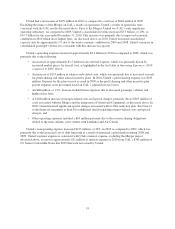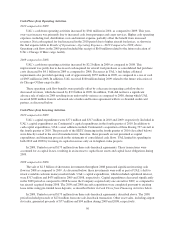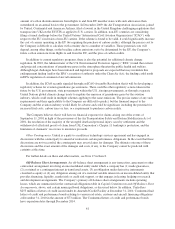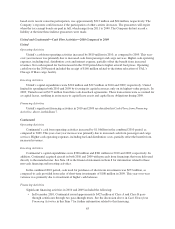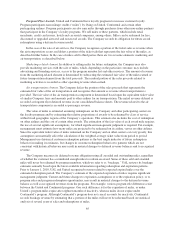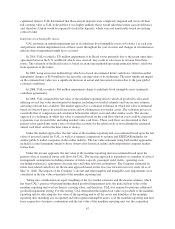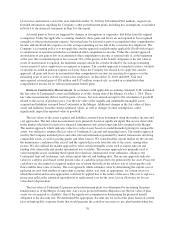United Airlines 2010 Annual Report Download - page 63
Download and view the complete annual report
Please find page 63 of the 2010 United Airlines annual report below. You can navigate through the pages in the report by either clicking on the pages listed below, or by using the keyword search tool below to find specific information within the annual report.amount of carbon dioxide emissions from flights to and from EU member states with such allowances then
surrendered on an annual basis to the government. In December 2009, the Air Transportation Association, joined
by United, Continental and American Airlines, filed a lawsuit in the United Kingdom challenging regulations that
transpose into UK law the EU ETS as applied to U.S. carriers. In addition, non-EU countries are considering
filing a formal challenge before the United Nations’ International Civil Aviation Organization (“ICAO”) with
respect to the EU’s inclusion of non-EU carriers. If the scheme is found to be valid, it could significantly increase
the cost of carriers operating in the EU (by requiring the purchase of carbon credits), although the precise cost to
the Company is difficult to calculate with certainty due to a number of variables. Those potential costs will
depend, among other things, on the baseline carbon emissions yet to be determined by the EU, the Company’s
future carbon emissions from flights to and from the EU, and the price of carbon credits.
In addition to current regulatory programs, there is also the potential for additional climate change
regulation. In 2010, the Administrator of the U.S. Environmental Protection Agency (“EPA”) found that current
and projected concentrations of greenhouse gases in the atmosphere threaten the public health and welfare.
Although legal challenges have been initiated and legislative proposals are expected that may invalidate this
endangerment finding (and/or the EPA’s assertion of authority under the Clean Air Act), the finding could result
in EPA regulation of commercial aircraft emissions.
In addition, the ICAO recently signaled through an ICAO Assembly Resolution that it will be developing a
regulatory scheme for aviation greenhouse gas emissions. There could be other regulatory actions taken in the
future by the U.S. government, state governments within the U.S., foreign governments, or through a separate
United Nations global climate change treaty to regulate the emission of greenhouse gases by the aviation
industry, which could result in multiple schemes applying to the same emissions. The precise nature of any such
requirements and their applicability to the Company are difficult to predict, but the financial impact to the
Company and the aviation industry would likely be adverse and could be significant, including the potential for
increased fuel costs, carbon taxes or fees, or a requirement to purchase carbon credits.
The Company believes that it will have no financial exposure for claims arising out of the events of
September 11, 2001 in light of the provisions of the Air Transportation Safety and System Stabilization Act of
2001, the resolution of the majority of the wrongful death and personal injury cases by settlement and the
withdrawal of all related proofs of claim from UAL Corporation’s Chapter 11 bankruptcy protection, and the
limitation of claimants’ recoveries to insurance proceeds.
Other Contingencies. United is a party to a multiyear technology services agreement and has engaged in
discussions with the counterparty to amend or restructure certain performance obligations. In the event that these
discussions are not successful, the counterparty may assert claims for damages. The ultimate outcome of these
discussions and the exact amount of the damages and costs, if any, to the Company cannot be predicted with
certainty at this time.
For further details on these and other matters, see Note 17 in Item 8.
Off-Balance Sheet Arrangements. An off-balance sheet arrangement is any transaction, agreement or other
contractual arrangement involving an unconsolidated entity under which a company has (1) made guarantees,
(2) a retained or a contingent interest in transferred assets, (3) an obligation under derivative instruments
classified as equity or (4) any obligation arising out of a material variable interest in an unconsolidated entity that
provides financing, liquidity, market risk or credit risk support, or that engages in leasing, hedging or research
and development arrangements. The Company’s primary off-balance sheet arrangements include operating
leases, which are summarized in the contractual obligations table in Capital Commitments and Off-Balance Sheet
Arrangements, above, and certain municipal bond obligations, as discussed below. In addition, United has
$253 million of letters of credit issued under its Amended Credit Facility at December 31, 2010. Continental had
letters of credit and performance bonds relating to various real estate, customs and aircraft financing obligations
at December 31, 2010 in the amount of $73 million. The Continental letters of credit and performance bonds
have expiration dates through December 2014.
61




